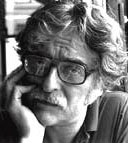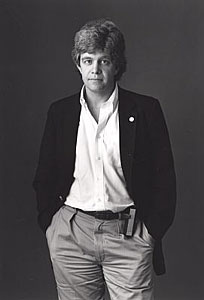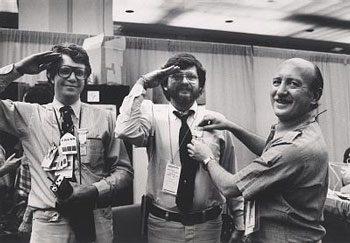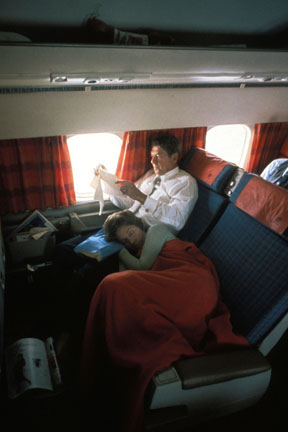 |
→ January 2006 Contents → Column
|
Nuts & Bolts
Michael Evans |
 |
|||||||||
|
In the early morning hours of December 1, 2005, Michael Evans died. It was the end of a four-year battle against cancer. He died on his wife's, Story's, birthday.
Michael came from a period in which nobody went to school to learn "photojournalism." (It was called "news photography." And education was for something more important.) Photography was a hobby. You loved it. Only when you learned you could get into football games for free did it become your profession.
Five years later he was shooting for the Cleveland Plain Dealer, then The New York Times and then Time magazine. He was very good.
Time magazine put freelance photographers under contract, guaranteeing them a minimum number of work days. But they could shoot for other magazines not in direct competition with Time. Michael was working for Equus, a magazine devoted to horses, when he made the iconic shot of Ronald Reagan in a cowboy hat. Thus, when the Reagan presidential campaign began, Time put Michael on it full-time. And when the campaign was over, President Reagan asked Michael to be his personal photographer.
Photographers become identified in the public's eye with a single shot or a single subject. Michael's Time cohort, Eddie Adams, will always be identified with war and his photograph of General Nguyen Ngoc Loan executing a Viet Cong prisoner in Saigon. Another Time cohort, Carl Mydans, will always be identified with his shot of General MacArthur wading ashore in the Philippines. Michael will always be identified with his coverage of President Reagan. And that is a very limited view of the amazing accomplishments of any of these folks.
Once, towards the end of Michael's life, when Arthur Grace and I were visiting and Michael was taking a nap, Story started showing us boxes of prints from the pre-Reagan era.
I was out of the country a good deal of the time that Michael was working at the White House. When I was back here, I was pretty far from Washington. Still, I heard about what Michael was doing at the White House. For one thing, he was helping the other news photographers who were assigned to cover the president. That "helping others" stuff was never too big among the Washington press corps and still doesn't seem to be making a lot of headway in other arenas of photojournalism. But it was a signal of much of what Michael would do after the White House.
Personal photographer to the president is a pretty demanding job. Michael had four other photographers working with him, but covered most of the president's working hours and weekends at Camp David. The president also preferred that Michael cover his personal time.
I think Michael was extremely accurate when he described the job as similar to being a valet. He was asked to be invisible, always available and absolutely trusted. This was, perhaps, more demanding than the actual photography.
I'm told 595 people were photographed; there are almost 300 in the book. I'm sure it took longer to negotiate the sitting than to take the picture of some of the power figures.
(And, while it is a minor note, Michael learned how to light and shoot very well with a big camera. I visited his studio one day and when I got back to NYC, immediately duplicated his lighting set-up. My wife, my children and my friends owe their rather attractive studio portraits to Michael Evans.)
I think, somehow, that those years in Washington put the role of "photographer" in perspective for Michael. I said earlier that one of the things Michael did at the White House was to help other photographers. To a great extent, that's what he did when he left the White House.
In 1987, as executive producer and editor, Michael produced another book, "Homeless in America" (ISBN 0-87491-888-X), along with a traveling exhibit for the National Mental Health Association and Families for the Homeless. He organized lawyers, art directors, darkroom workers, a writer and volunteer photographers. He also got Mary Ellen Mark, myself, Eli Reed, Gene Richards and Steve Shames paying jobs to just go off and photograph homelessness.
Before the book was published, the man in charge of the specific project I was photographing was suspected of having sex with one of his young, male charges. Most of my work went directly to the wastebasket. A few pictures were in the traveling exhibit. Mary Ellen said she thought one of them was very good. The first picture in the main section of the book is mine, but it is just there to establish the location where I found a poem written on a discarded piece of note paper.
"Darkness has not path
You look back
You hear noises
For some reason, you go on.
(Poem found in abandoned tent, Burlington, Vermont, July, 1987)
The poem opens the main section of photographs in the book.
Peter Jennings read the poem to open an ABC-TV story on homelessness that used pictures from the project.
So, I didn't get any big spreads. I was pissed off. And, somehow, Michael made that OK. Long before I realized it, he knew how much I had gotten out of the homeless project and banged it into my head and stopped my whining. It was an amazing trip. He gave me something I will never forget. I should have thanked him the last time I saw him, but I forgot.
For a short while Michael was photo editor of the Atlanta Constitution-Journal. He also developed some amazing software for use with photo collections as diverse as those of museums and news agencies. He was working with the photo agency, Zuma. But we hadn't seen each other for some while until he came to New York City to attend the memorial service for Eddie Adams.
The cancer treatment had left him bald as a billiard ball, with a significant weight gain and very tired. Yet there he was, riding the subway, laughing, having a meal and keeping up with a bunch of old photographers who reach critical mass if more than two of them are in a room at the same time.
After that we remained in touch by e-mail and phone; I even got to see him at his normal weight and with hair.
When Michael died, his friend, Arthur Grace, put this statement on the Zuma Web site:
"Michael Evans had it all as a photojournalist -- intelligence, wit, curiosity, tenacity, an abundance of class and prodigious talent with a camera. He was a consummate professional and a true gentleman. He will be sorely missed by all those who had the pleasure of working with him or competing against him. Fortunately, his iconic photographs will keep his reputation growing and his memory alive."
There was one thing that Michael did not have: self-pity. He was absolutely devoid of it. Occasionally, in the most matter-of -act way, when talking about a specific project, he would refer to the fact that his time was limited. Even then he did it in a way that sounded like he had to leave for the airport to catch a plane.
He's left. He's caught the plane. It's very sad.
© Bill Pierce
Contributing Writer
|
||||||||||
Back to January 2006 Contents
|
|


